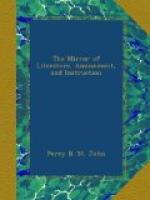The association of gardening with pastoral poetry, was exemplified in Shenstone’s design of the Leasowes—as Mr. Whately observes—a perfect picture of his mind, simple, elegant, and amiable, and which will always suggest a doubt whether the spot inspired his verses, or whether in the scenes which he formed, he only realized the pastoral images which abound in his songs. That elegant trifler, Horace Walpole, was enthusiastically fond of gardening. One day telling his nurseryman that he would have his trees planted irregularly, he replied, “Yes, sir, I understand; you would have them hung down—somewhat poetical.”
PHILO.
* * * * *
NOTES OF A READER.
* * * * *
PORTRAIT OF SIR WALTER SCOTT.
Appended to a fine portrait of Sir Walter Scott, in
the Literary
Souvenir for 1829, is the following—by
Barry Cornwall:—
We can scarcely imagine a thing much more pleasant indeed, to an artist, than to be brought face to face with some famous person, and permitted to examine and scrutinize his features, with that careful and intense curiosity, that seems necessary to the perfecting a likeness. It must have been to Raffaelle, at once a relaxation from his ordinary study, and a circumstance interesting in itself, thus to look into faces so full of meaning as those of Julius and Leo—and to say, “That look—that glance, which seems so transient, will I fix for ever. Thus shall he be seen, with that exact expression (although it lasted but for an instant) five hundred years after he shall be dust and ashes!”
This was probably the feeling of Raffaelle; and it must have been with a somewhat similar pride that our excellent artist, Mr. Leslie, accomplished his portrait of Sir Walter Scott, which the reader will have already admired in this volume. It is surely a perfect work. No one, who has once seen the great author, can forget that strange and peculiar look (so full of meaning, and shrewd and cautious observation—so entirely characteristic, in short, of the mind within) which Mr. Leslie has succeeded in catching. One may gaze on it for ever, and contemplate an exhaustless subject—all that the capacious imagination has produced and is producing,—the populous, endless world of fancy.




